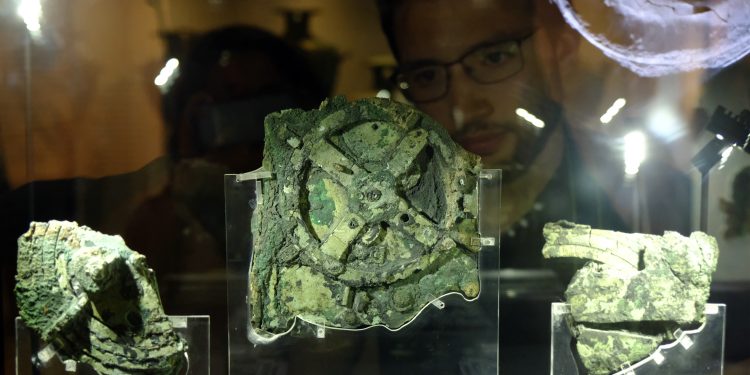There are numerous mysterious ancient inventions, the discovery of which has left archaeologists and scientists equally dumbfounded. Some point toward aliens, and time travel, but the truth is that we are simply seeing how well developed and advanced ancient civilizations were.
While the purpose of some inventions has left the archaeologists perplexed, the ancient technology behind others was not in existence even as late as the 18th century.
Antikythera Mechanism
Discovered by divers exploring a Roman shipwreck in the Aegean, the Antikythera mechanism has left the world mystified. Antikythera Mechanism, a plate bearing multiple gears, is described as the earliest example of a Greek-era analog computer.
The purpose of this ancient, hand-powered orrery was to predict eclipses and planetary positions, along with keeping track of the ancient Olympic games, which took place every four years. The level of mastery still leaves today’s scientists awestruck.
Greek Fire
Wielded by the Byzantine empire in the 7th century for naval warfare, Greek Fire was lethal and nearly impossible to extinguish even with water. Greek Fire could engulf an entire ship within minutes. Luckily, the exact composition of Greek Fire is still a mystery to this date.
Damascus Steel
Damascus Steel, wielded by Islamic warriors during crusades, could flex back unscathed after bending 90 degrees and even cut through handkerchiefs while they were still floating. Even with today’s scientific advancements, modern scientists are as perplexed about the exact recipe of Damascus Steel as the European crusaders were centuries ago.
Seismoscope of Zhang Heng
The first seismoscope was invented by Zhang Heng- the Leonardo da Vinci of China, in the year 132. Until now, scientists have not been able to unveil the mechanism that allowed the seismoscope to detect earthquakes beyond the range of thousands of kilometers remotely.
Was it as simple as a pendulum-based system or something more complex? Even after multiple reconstruction attempts, the exact mechanism behind the ornate Zhang Heng seismoscope is still a mystery today.
Phaistos Disk
Originally unearthed in Crete in 1908, the intriguing Phaistos Disc is a small, circular clay disk, 6-inches in diameter, which dates back to approx. 1700 BC. This disk features 241 symbols arranged in a spiral.
The exact use of the disk is still unknown. Some early theories associate it with an ancient proto-typewriter, while others associate it with a simple clay disk containing sheet music or prayers dedicated to a Minoan deity.
Ulfberht Swords
Dating back to the 9th and 10th centuries, the legendary Ulfberht swords have left archaeologists perplexed. The technology and skill required to produce such strong and pure metal did not come into existence for another 800 years.
Theories suggest that the Vikings could have employed materials and techniques similar to Damascus steel to forge their legendary Ulfberht swords.
An Arabic inscription bearing Viking swords was discovered in 2014. This discovery strengthened the credence of the theory that Viking swords were created using Damascus steel. How the Damascus steel recipe traveled beyond the Mediterranean still remains a mystery.
Stone Spheres of Costa Rica
Dating approximately 200 BC to AD 800, these colossal stone balls discovered in Costa Rica are as mysterious as they sound. Scientists have deduced that the natives used the technique of “fracture, pecking and grinding” to reduce large igneous stone-granodiorite into these stone spheres.
As for their purpose, some believe that the spheres were used as navigational tools or calendars, while others believe that they were used as storage for gold.
Lycurgus Cup- Roman Nanotechnology
Acquired by the British Museum in the 1950s, the Lycurgus Cup is a Roman Chalice that dates back to the 4th century. The mystifying attribute of the Lycurgus Cup is that it appears to change its colors according to the direction of light. On being lit from behind, it turns jade green, whereas on being lit from its front, it turns blood red!
Researchers studying the chalice attributed this property to the Roman craftsmen’s mastery of nanotechnology as they finely ground gold particles to 50 nanometres across for its creation.
This discovery and level of precision indicate that Romans were, in fact, masters of nanotechnology at the time of creating the cup!
The Baghdad Batteries
Discovered in 1936 in a Palaeolithic village outside Baghdad, the ‘Baghdad Battery’ consist of clay pots lined with copper cylinders running through their lengths. These copper cylinders further contained iron rods which were cemented in place by asphalt.
Archaeologists confirmed the nature of the Baghdad Batteries after a decade as experiments unveiled that they contained an electrolyte fluid and the pots generated up to two volts of electricity. The mystery revolves around the usage of these ancient batteries and what they powered.
Roman Dodecahedron
Discovered in 1739, the Roman Dodecahedron are 4-11 centimeters sized hollow objects made of a copper alloy. Each flat surface has a hole connecting the main hollow center.
Dating back to the 2nd and 4th Centuries AD, the purpose of using these artifacts is still unknown. The wide-ranging theories revolving around these are that they were ancient candle holders, souvenirs, or perhaps a game or were simply used to measure people’s ring sizes.
Join the discussion and participate in awesome giveaways in our mobile Telegram group. Join Curiosmos on Telegram Today. t.me/CuriosmosResearchrs











